Plant a Tree This Fall

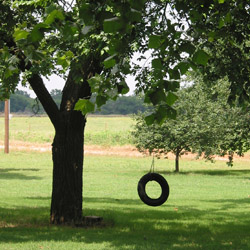 There are so many reasons to add a new tree to your landscape this fall that it’s hard to find a reason not to.
There are so many reasons to add a new tree to your landscape this fall that it’s hard to find a reason not to.
Just think about it, trees will…
- Beautify the Environment
Trees add texture and color to the landscape. They soften the harsh lines of buildings and driveways, while their foliage and blooms add seasonal color changes and variety.
- Stabilize Soil
Tree roots prevent soil from blowing or washing away, minimizing erosion and providing protection for the surrounding landscape.
- Provide Wildlife Habitat
Trees provide shelter and food for birds and numerous small animals, including squirrels, raccoons, insects and more.
- Make Food
Many trees provide fruits, nuts, seeds, sap and berries for human consumption. Wildlife will also rely on the food provided by trees.
- Create Oxygen
Through photosynthesis, trees take in carbon dioxide, carbon monoxide, sulfur dioxide and other poisons from our air and release pure oxygen for us to breathe. One tree can produce enough oxygen for 10 humans for one year!
- Filter the Air
Trees act as giant filters trapping dust and pollution particles with their leaves and bark until the rain washes the particles away.
- Cool the Air
Air will remain several degrees cooler in the shade of a tree canopy. This is accomplished by not only by blocking the sun’s rays but also through transpiration. Tree leave transpire, or release moisture, which cools the surrounding air. A large tree can release as much as 400 gallons of moisture from its leaves daily.
- Reduce Utility Bills
Deciduous trees planted on the south and southwest sides of a home will shade the structure during hot summer months and reduce air conditioning or other cooling needs. In the winter, with the leaves fallen, the sun is able to warm the structure, reducing heating bills.
- Reduce Noise Pollution
Strategically planted, trees can dramatically reduce the volume of unwanted noise from loud neighbors, nearby businesses or car traffic.
- Hide undesirable views
Purposefully sited, trees can camouflage unattractive views and create privacy, providing a natural sanctuary in your yard.
In our area, fall is just about the best time of year to purchase and plant a tree. The soil is warm, air temperature is cool and morning and evening dew increase available moisture to nurture a new tree. Stop in and see our extensive collection, and we can assist you in choosing the tree that is perfect for your landscape and lifestyle needs.
Autumn: Why Plant Now?
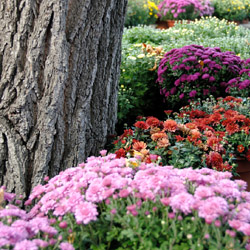 Although many gardeners plant trees and shrubs in the spring, knowledgeable gardeners plant in the fall to take advantage of all this fabulous season has to offer. But why is fall planting better than spring planting?
Although many gardeners plant trees and shrubs in the spring, knowledgeable gardeners plant in the fall to take advantage of all this fabulous season has to offer. But why is fall planting better than spring planting?
- Stress Reduction
Transplanting causes stress as plants are removed from containers, balls or established locations and changed to new locations. Planting in the fall, when a plant is entering dormancy and is generally hardier and sturdier, reduces this stress so the plant can thrive.
- Establishing Strong Roots
Fall planting “establishes” trees and shrubs by encouraging root growth. Because the soil is still warm, the roots continue to develop until freezing, though the upper parts of the plant are already dormant. When transplanting in the spring, the developed roots are active and delicate tips or rootlets, as well as buds and new leaves, are more easily damaged.
- Weather Resiliency
Trees and shrubs planted in the fall are better able to withstand the rigors of the next summer’s heat and dry conditions because they have much longer to develop healthy roots systems and become thoroughly established. This is especially critical in dry climates or areas prone to drought or irregular rainfall.
- Faster Maturity
The “head-start” of fall planting results in a larger plant in less time, helping create a mature landscape without waiting for smaller plants to catch up. This can be especially critical when replacing dead or damaged plants in a mature landscape to avoid a gap or uneven look.
- Water Conservation
Planting in the fall saves watering time and promotes conservation by eliminating daily watering. Cooler temperatures with the addition of both morning and evening dew contribute greatly to soil moisture availability in fall without as much supplemental watering.
- Color Confirmation
Fall is the best time to see a plant’s autumnal color. Planting in the fall eliminates the surprise of the wrong color or unexpected shades that may not coordinate with nearby plants. By planting in autumn, you’ll know exactly what you’re purchasing and planting, and you will be able to match better with your existing landscape.
- Saving Money
Last but definitely not least, buying your beautiful trees and shrubs in autumn can save big money. We discount prices on trees and shrubs to create room for holiday season materials and pass the savings on to you. Selection may be more limited later in fall, however, so don’t wait too long to take advantage of great savings.
Autumn can be the ideal time to plant trees and shrubs, whether you are adding to your landscape, replacing plants or starting a whole new look. If you plant in autumn, you’ll be amazed at how lovely your landscape will look next spring.
Fall Gardener’s Calendar
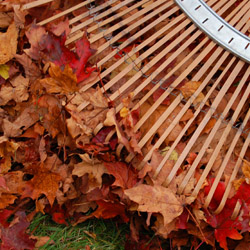
 SEPTEMBER
SEPTEMBER
Spray Bonide All-Season Spray on hemlocks to control woolly adelgid.
Spruce up the landscape by planting Fall Pansies, Flowering Cabbage & Kale, Garden Mums, Fall-Blooming Perennials as well as Trees and Shrubs.
Test your lawn pH to determine if you need to apply lime this season. A 5o lb. bag of Lime will raise the pH about a half a point per 1000 square feet of turf.
Pick up your Spring Flowering Bulbs like tulips, daffodils, crocus, hyacinths, snowdrops and more! An Auger for the drill will also help make planting easier.
Plant cool-season salad greens (arugula, corn salad, lettuce, radishes and spinach) in cold frames.
Apply Superphosphate now to coax stubborn plants into bloom next year.
Aerate, re-seed and apply Fall Lawn Food to the lawn. Keep grass seed damp; water every day if necessary. You will also want to check for grubs. Increased activities of skunks, raccoons and moles as well as brown patches that peel back easily are an indication of grub activity. Apply granular Sevin to control the grubs as well as chinch bugs and sod webworm.
Treat houseplants with Systemic Granules and Concern Insect Killing Soap now to get rid of any insects before bringing them into the house prior to the first frost.
Clean out garden ponds and pools. Cover with Pond Netting before the leaves start falling.
OCTOBER
Plant bulbs. Fertilize with Espoma Bulb-Tone and water in well.
Divide daylilies and spring-blooming perennials, including iris and peonies. Don’t be tempted to prune your spring flowering shrubs like forsythia, azaleas, camellia, holly, lilac, rhododendron, spirea or viburnum or you will destroy next year’s buds.
Rake leaves from the lawn and lower the mower blade. Check your compost pile. Now is a good time to add Concern Bio Activator to help break down brown leaves and lawn clippings.
Dig up summer-flowering bulbs, such as dahlias, cannas, tuberous begonias, caladiums and gladiolus after the frost kills the top growth. Treat them with Bulb Dust, pack them in Peat Moss, and store them in a ventilated area for winter.
Fertilize your trees with Jobes Tree Spikes after the leaves fall. Fertilize azaleas, rhododendron, and evergreens with Holly-Tone and other shrubs with Plant-Tone. Spray hemlock again with Bonide All-Season Spray Oil.
Set up bird feeders. Clean out birdbaths, refill and purchase heaters for the winter.
Clean up and destroy diseased rose leaves and debris surrounding shrubs and perennials. Mound 10-12 inches of dirt around roses to protect from winter damage. After the ground freezes, cover roses with mulch or straw.
Remove annuals, roots and all, and add to your compost pile, but do not add any diseased material to it.
Cut back perennials unless they feature ornamental seed heads and Fertilize with 5-10-5. Prune long raspberry and rose canes back to a height of three feet. Clean up your beds and gardens to avoid harboring insects and diseases over the winter.
Pot hardy spring bulbs (anemone, crocus, daffodil, hyacinth, ranunculus and tulip) and place in a cold frame or cool garage (40 degrees) or sink into the ground and mulch. Keep evenly moist.
Update garden records, noting successes and failures, gaps in planting, future planting and landscape changes.
Water all landscape plants well and mulch before the winter cold sets in.
Spray evergreens, azaleas, rhododendron, boxwood and rose canes with Wilt Pruf for protection against wind and cold weather.
Tulips: Spring Starts Now!

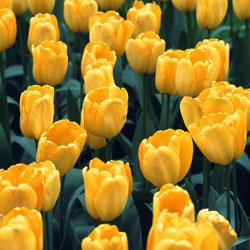 Members of the lily family, tulips are native to central and western Asia. In the 16th century, they were introduced to the Netherlands where most tulip bulbs are grown today. With over 100 species and nearly 3,000 varieties, tulips have been divided into 14 groups, including Darwin hybrids, Triumph, Lily-flowering, Double early, Rembrandt, Scheepers’ Hybrids (or French) and Parrot variations. Their classification is based on form and habit. A 15th group includes species tulips with the smallest plants growing to just 3 inches.
Members of the lily family, tulips are native to central and western Asia. In the 16th century, they were introduced to the Netherlands where most tulip bulbs are grown today. With over 100 species and nearly 3,000 varieties, tulips have been divided into 14 groups, including Darwin hybrids, Triumph, Lily-flowering, Double early, Rembrandt, Scheepers’ Hybrids (or French) and Parrot variations. Their classification is based on form and habit. A 15th group includes species tulips with the smallest plants growing to just 3 inches.
Tips for Planting Tulips
Tulips are an easy care addition to any landscape, and they are easier to plant than many gardeners realize.
- Choose only top-sized bulbs without any bruises or obvious damage. Bigger bulbs generally indicate better quality and bigger flowers.
- Plant bulbs as soon as purchased or store in a cool, dry location.
- Choose a sunny (or part sun) location with well-drained, rich soil.
- Plant 2” deeper than recommended to promote re-blooming each year.
- Apply bone meal 3 times a year – in fall when you plant, in spring as bulbs emerge from the ground and after flowering has finished. This will provide food for the foliage and bulb growth for next year’s flowers.
- Protect tulip bulbs from pest damage by laying wire mesh on top of your bed just beneath the soil. Sprinkling VoleBlok in the holes when planting can also be helpful.
- Mulch and water the bed thoroughly after planting.
- Plant before the ground freezes.
- Deadhead flowers after they have faded, but leave the foliage to die back naturally. Do not cut off the leaves until they have turned brown, or else they will not develop large enough bulbs for a good show the next year.
Tulip Timesaving Tip
Don’t have much time to plant a large, luxurious tulip bed? Plant 100 tulips in just 1 hour!
- Choose a part to full sun location and dig a hole 6’ x 6’ to a depth of 6-8”, placing the displaced soil on plywood or cardboard.
- Place 100 tulips, pointed end up, evenly over the area.
- Gently slide the soil from the plywood or cardboard onto the tulip bulbs. Tamp the soil lightly, sprinkle the bed with bone meal and water well. In spring, the entire area will bloom!
Tried & True Tulip Selections
Some tulips can be finicky, and while some tulips will disappear from your garden after a year or two, these selections promise trouble-free blooms for years!
- ‘Daydream’ – Darwin tulip, changing colors while in bloom to vibrant apricot-orange, blooms mid-April into May, Ht: 22”. Fragrant.
- ‘Lilac Wonder’ – Species tulip, large rose-lilac flowers with yellow bases and anthers, blooms May, Ht: 7”. Prefers full sun.
- T. praestans ‘Fusilier’ – Multi-flowering species tulip, orange-scarlet flowers, blooms April, Ht: 8-12”.
- T. clusiana var. chrysantha – Species tulip, good naturalizing tetraploid, deep yellow flushed with rose toward the edges, blooms April, Ht: 8”.
- ‘Pink Impression’ – Darwin tulip, huge flower with strong, clear pink flowers, blooms mid-April to May, Ht: 22”.
- ‘Menton’ – Scheepers’ hybrid, blooms are shades of apricot, rose, pink and peach, late-blooming, Ht: 26”.
- ‘Mrs. John T. Scheepers’ – Huge Scheepers’ hybrid, golden-yellow tetraploid is a three-time award winner, late-blooming, Ht: 26”.
- ‘Persian Pearl’ – Species tulip, deep magenta-rose with buttercup yellow star on the inside, blooms April, Ht: 6”.
- ‘Maureen’ – Scheepers’ offspring, large, oval-shaped flowers of glistening white, blooms late-May, Ht: 28”. Four-time award winner!
- ‘La Courtine’ – A Scheepers hybrid, yellow flowers are oval-shaped, flamed with red from the bottom up, late-blooming, Ht: 26”.
With so many to choose from, it’s always time for tulips!
Fourth of July Porch Pots
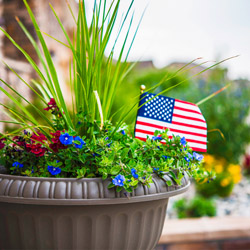
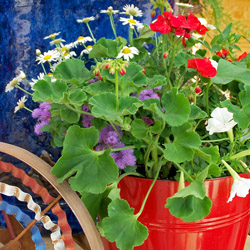

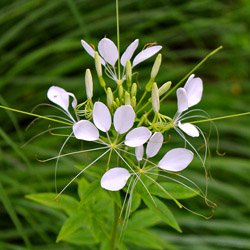
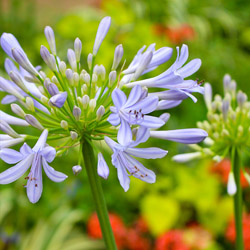 A porch pot can be a beautiful accent to any entryway, and with a bit of patriotic flair, you can easily style a Fourth of July porch pot as a decorative highlight for all your summer festivities. By carefully designing the pot and the plants it showcases, it can burst into festive glory just in time for the holiday.
A porch pot can be a beautiful accent to any entryway, and with a bit of patriotic flair, you can easily style a Fourth of July porch pot as a decorative highlight for all your summer festivities. By carefully designing the pot and the plants it showcases, it can burst into festive glory just in time for the holiday.
Beyond the Porch
A porch pot is traditionally an elegant container positioned at the main front entryway, but for summer porch pots it’s fun to look beyond the porch for where to show off your festive container. Where will you be greeting guests and entertaining during the summer months? Any gathering spot can be made more seasonal with the right porch pot, so consider placing one or more pots…
- In the corners of a deck or patio
- Spaced along a bare section of fence
- On stairs leading up to a deck or porch
- Framing an outdoor kitchen or grill area
- Accenting a pool surround
- As an outdoor table centerpiece
Wherever your pots can be seen, they’re sure to add a patriotic bit of color to give a party-like atmosphere to your outdoor living spaces.
Picking the Pot
When choosing a container for a Fourth of July pot, first consider where the pot will be located and choose an appropriate size for that location. Be mindful that the pot will not block walkways or cause a trip hazard on stairs, and be sure it is sturdy enough to hold up the plants you want to showcase.
The pot style can vary, and choosing a pot with patriotic colors can add instant flair to your decorative arrangement. Red, white, or blue pots are always popular choices, or the pot could be painted with a patriotic theme such as stars and stripes. Spattering a white pot with red and blue is a more subtle but festive option, or larger polka dots could be a bold and colorful statement. To honor a military connection, consider a pot with a camouflage pattern, or choose a more demure, understated pot to let the plants be the true stars of the arrangement.
Top Fourth of July Flower Picks
You can add any type of flowers you’d like to a Fourth of July porch pot, but red, white, and blue blooms are always favorites. Fortunately, there are many flower choices that can work into this color palette, including…
- Red – Petunia, zinnia, verbena, cardinal flower, impatiens, geraniums, nasturtium
- White – Zinnia, dahlia, geranium, verbena, daisy, petunia, cleome, vinca, snapdragon, impatiens
- Blue – Agapanthus, clematis, scabiosa, verbena, wishbone flower, lobelia, salvia, ageratum
In addition to bloom colors, you can also consider flower shape and opt for star-shaped blooms such as lilies, pentas, or star jasmine. Tall, flowing grasses with arcing plumes are another elegant option that mimics the gracefulness of fireworks. The round balls of allium and the spikes of salvia are other interesting shapes popular in patriotic displays.
Whichever plants you choose for your pot, remember the thriller-filler-spiller rule of thumb to create a lush, eye-catching arrangement, and it will sure to be a stunning decoration.
Planting Your Pot
Ideally, a Fourth of July porch pot should be planted several weeks before the holiday or any summer event so the plants have a chance to settle and fill in the pot before the celebration. If you’ve chosen a larger pot, add a layer of rocks or a brick or two to the bottom of the pot so it is properly weighted and will be less likely to tip over if accidentally bumped. Choose high quality potting soil to give each plant the proper nourishment, and ideally choose plants that all have similar sunlight and watering needs so they will thrive together.
Summer Porch Pot Care
Once planted, you will need to give your Fourth of July porch pot the proper care so it continues to look its best. Positioning the pot on a moveable stand or casters will help you be sure it has adequate light even as shadows shift from week to week, and rotating the pot will ensure the plants grow evenly. Water the pot appropriately, bearing in mind that smaller pots will need more frequent watering, especially on hot summer days. Fertilizing should not be necessary if you’ve used high quality potting soil, but if needed, fertilize sparingly to avoid burning roots or causing uneven growth. As the plants get taller, stake them if necessary, and protect the pot from sudden summer storms so it is not tipped or flooded.
Decorative Accents for a Fourth of July Porch Pot
It’s easy to add a bit of holiday flair to the pot if you choose decorative stakes with a red, white, and blue theme. Miniature flags are a popular choice, or you can find metallic sprays or faux firework rockets that will add a fun touch to the arrangement. Pinwheels are another great option that add a bit of movement to the pot.
Tying a ribbon around the pot can also add a holiday touch. Choose red, white, or blue ribbons, or opt for a rustic theme with gingham or checked patterns. Gold ribbons can also be a meaningful way to honor military members and deployed troops.
Be creative and fun with decorative accents for your porch pot, and it will be an eye-catching, attractive arrangement and a focal point for all your summer holiday entertaining.
Plant a Patriotic Flower Garden
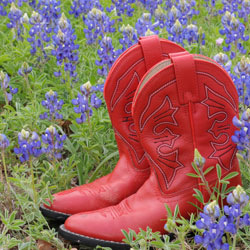

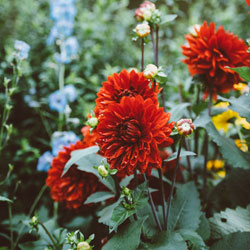
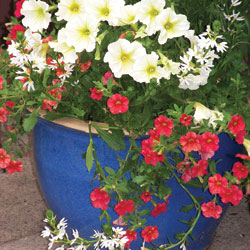 A patriotic flower garden can be a great way to show off your national pride, support a military serviceman or servicewoman, or just add decorative flair to your yard or landscaping for summer holidays. With careful steps, your flower garden can be filled with red, white and blue pride for the entire neighborhood to enjoy.
A patriotic flower garden can be a great way to show off your national pride, support a military serviceman or servicewoman, or just add decorative flair to your yard or landscaping for summer holidays. With careful steps, your flower garden can be filled with red, white and blue pride for the entire neighborhood to enjoy.
When to Be Patriotic
While a red, white and blue flower garden can be enjoyed any time from early spring through late fall, these color combinations are more popular for celebrating summer holidays. From Memorial Day in late May through Flag Day (June 14), Independence Day (July 4) and even to Labor Day in early September, a patriotic flower garden can be the perfect decoration. These designs are also popular for summer barbecues, family reunions and other celebrations. Whenever you want your garden to be in its full, colorful bloom, however, be sure to choose suitable flowers with planting times and growth habits that ensure they look their best on the desired date.
Planning the Flower Garden
You can turn an existing flowerbed into a patriotic display or plan an entirely new flower garden to show your patriotic pride. Regardless of which flowerbed you use, there are different factors that should be considered to make sure the bed looks its very best.
- Size
Any size flower garden can show patriotic colors, but it needs to be carefully designed so all the colors are seen equally. Larger flowerbeds are easier to design colorfully, though it does also depend on where the flower garden is positioned. If the garden is in a very visible space, a smaller garden can be just as delightful as any larger flowerbed. For mini gardens, patriotic plantings may be constructed in a single pot with one thriller, one filler and one spiller plant to give the arrangement balance and movement. - Shape
Any flowerbed shape can be patriotically designed, whether it is a small, narrow bed, a larger round bed, a spot beneath a tree or alongside a house or fence. A curved bed might lend itself well to a “waving flag” type of design, while a round bed could become a star pattern. Simple color blocking can be used in any bed shape to create a patriotic color scheme. - Location
It is important that a patriotic flower garden be visible, not only for your enjoyment, but also for your guests, whether those guests are neighbors passing by your yard, visitors enjoying a barbecue party or anyone else who may see the bed. Properly positioned, the flower garden can be a welcome statement for your yard as well as a focal point for your landscape. - Design
There are many beautiful designs for patriotic flower gardens. You could create an image in flowers, such as planning colors and arrangements to mimic an American flag, or you might create star shapes with the different colors. Simply balancing patriotic colors in different tiers can be a lovely option as well.
Coloring Your Patriotic Flower Garden
There are many different and beautiful ways to incorporate red, white and blue into a patriotic flower garden, both with plants as well as decorative accents.
- Red
Popular red flowers for a patriotic bed include astilbe, gerbera daisies, cockscomb, dianthus, begonias, dahlias, poppies, camellias, impatiens, geraniums, petunias, salvia and ranunculus. Choose flowers with bold, rich red shades that aren’t too pale or pinkish. Other red accents could include red brick edging, a bright red gazing ball, red hummingbird feeders or even red mulch such as wood chips or lava rock. - White
White stone edging, a short decorative fence or river rocks can frame a patriotic flower bed, and there are many stunning white flowers to fill that bed. Heliotrope, astilbe, petunias, gerbera daisies, jasmine, camellias, peonies, chrysanthemums, yarrow, ranunculus, anemone, vinca, dahlia and hyacinth are just a few options that can add a burst of white to the bed. You can also consider red and blue flowers that have white accents in their blooms. - Blue
It can be difficult to find blue flowers with the proper rich hue for a patriotic flower garden. Options include cornflower, flax, globe thistles, periwinkle, salvia, harvestbells, desert bluebells, sweetpea and lobelia. To add more blue tones, consider a blue gazing ball, ceramic blue bird bath or blue containers and pots in the proper blue shades rather than having too much purple-like coloration.
More Tips for a Patriotic Flower Garden
There are many other fun ways to give your flower garden even more patriotic flair. Choose flower types that have star shapes in their blooms or coloration, or opt for big, bold blooms that resemble bursts of fireworks. Adding ornamental grasses to the bed can give it a sense of fireworks as well, or you can go vertical with a colored trellis or arbor, such as a blue structure to support red and white flowers. Add flag stakes to decorate the bed and there will be no mistaking its patriotic nature.
To be sure your garden looks its very best right before a party, holiday or other celebration, trim away excess greenery so as much red, white and blue color is exposed as possible. Also trim, prune or pinch away any blooms that have faded or discolored, especially white blooms that may be showing brown edges that can detract from the flowerbed’s beauty. With a little care and attention, your patriotic flower garden will be brimming with colorful spirit all summer long.
Easter Plant Guide
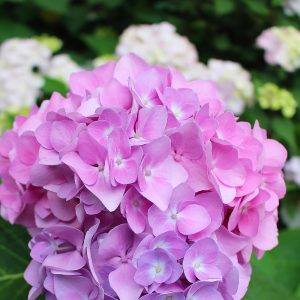
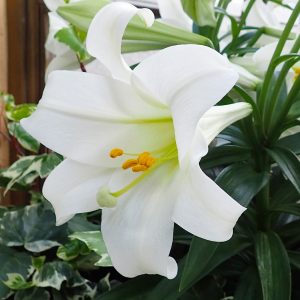

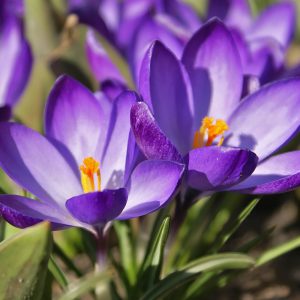 Easter is a season of rebirth and renewed growth in the garden, and many beautiful plants can be lovely gifts to celebrate this spring holiday. Whether you want to give plants as thoughtful Easter gifts to friends, family members, neighbors, coworkers, caregivers, teachers, or any other special person, or even just enjoy the plants yourself, this Easter plant guide can help you choose the best options to spread seasonal cheer.
Easter is a season of rebirth and renewed growth in the garden, and many beautiful plants can be lovely gifts to celebrate this spring holiday. Whether you want to give plants as thoughtful Easter gifts to friends, family members, neighbors, coworkers, caregivers, teachers, or any other special person, or even just enjoy the plants yourself, this Easter plant guide can help you choose the best options to spread seasonal cheer.
Before You Choose a Plant
When giving a plant as a gift for any occasion, consider the recipient’s needs and preferences to be sure the gift will be suitable. Is that someone special able to care for a larger potted plant, or would a smaller one be more appropriate? What are that person’s favorite plants or flowers, or what are their favorite colors? Do they have an interest in cultivating houseplants, or are they more suited to receive a potted plant that can be added to their garden or landscape?
By taking those factors into consideration, you can choose the best Easter plant to be a welcome and thoughtful gift, one that will demonstrate the season’s beauty and nature’s freshness long after Easter weekend has passed.
Top 10 Easter Plants
There are many choices for attractive Easter plants that can be wonderful gifts and attractive seasonal accents. The top plants associated with spring and Easter include…
- Easter Lily
The large, upright Easter lily plant is always a favorite in spring with its bold foliage and peaceful white blooms. This plant can come in single or multiple blooms depending on the size of the plant and is typically offered as a potted plant. - Lily-of-the-Valley
The delicate bell-shaped flowers of lily-of-the-valley are an early sign of spring, and these plants can be grown in containers or planted as groundcovers in areas with partial shade. They will spread rapidly, filling in an area with their fragrant blossoms. - Calla Lily
These elegant blooms have a modern, sophisticated flair and are available in both large and miniature varieties. Calla lilies come in many colors, from rich purples, reds, and pinks to paler shades of yellow, ivory, and white, offering choices for anyone’s favorite hues. - Daffodil
A classic spring flower, the sprightly daffodil is an early blooming bulb and easy to grow in containers of different sizes, making it ideal for a gift. Available in yellows and whites, this is a cheerful flower always suitable for Easter, and can be a cut flower as well. - Tulip
Tulips come in a wide range of amazing colors and variegated shades, so it is easy to find the perfect potted tulip bulb or cut tulips for anyone’s tastes. There are even variations in size and petal shape for even more uniqueness for these stunning flowers. - Miniature Rose
Roses are familiar flowers, and miniature rose bushes are a fun Easter gift for anyone who loves their beautiful aroma. Different colors and rose varieties are available for these potted gifts, and they make great houseplants year-round. - Crocus
Another classic, early-blooming spring bulb, crocuses are compact and ideal for containers, either alone or paired with other spring bulbs. Available in several different colors, these flowers can create a lovely pot for a gift arrangement. - Hydrangea
Large, bold flowers with multiple blooms in a bundle, hydrangeas are stunners as cut flowers as well as planted in the landscape. These flowers come in calming spring shades of pastel pink, blue, and purple, as well as soft white hues and pale greens. - Hyacinth
A colorful bulb that blooms in upright bundles, hyacinths come in bold colors as well as more classic spring shades. These are great flowers for containers and can easily be planted to bring color to the landscape for many years to come. - Easter Cactus
A close relative of the Christmas cactus, this succulent features fleshy, lobed foliage and colorful blooms that appear in spring. This plant is an easy-care choice and can live for many years in suitable containers.
While these plants may be classic options for Easter, any plant can be a wonderful gift to share the joy of the season or to decorate a table, mantle, windowsill, entryway, or other household niche. Another option, particularly in regions with long, severe, winters, is to give seeds as an Easter gift so they are ready to be planted as soon as spring does arrive, even if the holiday is too early for planting.
Giving a Plant for Easter
No matter what plant, bulb, or flower may be used as an Easter plant, a bit of decorative flair can tie it to the season and make it more festive. Opt for a fun, spring-themed pot in a bright hue, or one with a whimsical floral or Easter pattern. Adding an Easter ribbon or plant pick to an arrangement can give it a holiday touch, or pair the gift with additional items, such as a new pair of garden gloves, ergonomic hand tools, or a garden knee pad for even more usefulness as the gardening season warms. Be sure the plant itself is in prime condition just before being presented as a gift by pruning away any spent foliage or bruised blooms, and water it a day or two before the presentation so it is as fresh and lush as possible. This extra care will ensure the plant is healthy and able to be enjoyed for the entire Easter weekend, and the good thoughts and best wishes that accompany it will last long past the holiday.
Trackable Tools
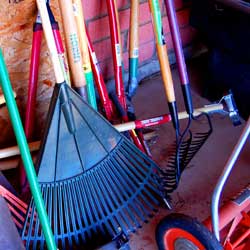 It’s the beginning of a new gardening season. Hopefully you took out last year’s journal in January or February and reviewed your notes on what you wanted to change, improve, experiment with or eliminate from your garden and landscape. Now is the time to begin implementing some of those great ideas, and it starts with having the right tools.
It’s the beginning of a new gardening season. Hopefully you took out last year’s journal in January or February and reviewed your notes on what you wanted to change, improve, experiment with or eliminate from your garden and landscape. Now is the time to begin implementing some of those great ideas, and it starts with having the right tools.
Where Do Your Tools Go?
One common problem in the garden is misplaced tools. We’ve all found hand tools in the spring that were inadvertently thrown in the compost pile or left under a shrub during fall cleanup. Many of us have spent time we didn’t have to spare walking in circles, looking for the shovel that we just had in our hand. It was laid down for a moment and seemed to disappear. Tools can easily disappear on a crowded workbench or in a cluttered shed, or they may even end up in a brush pile or other unlikely location.
When tools are lost, not only are our gardening chores impacted, but the tools can be damaged by exposure or accidental damage if they’re dropped, run over with a mower or otherwise subjected to inadvertent abuse. This can mean we no longer have the tool we need when we need it most, and we have to make a trip to the garden center to replace a tool – using time and money our gardening budget may not have.
Finding Your Tools
Let’s do things differently this year. Let’s save time, money and our precious tools. Resolve to only buy new hand tools with bright colored handles that are easily seen from afar and stand out to be picked up after a long day in the garden. If you already have a good selection of tools that you love and wish to keep track of, simply cover the handle with a bright colored spray paint on a sunny spring day, or wrap the handles with brightly colored tape or other coverings to make them more visible.
Similarly, take the time to clean out and declutter your garden shed, tool boxes and workbenches, making sure there is a safe, appropriate place to store every tool. If each tool has a place, you’ll be able to see at a glance when a tool may be missing and you can find it quickly before you’ve forgotten where you saw or used it last.
You and your garden will be glad you did!
Size Up Your Site, The First Step In Planning Your Landscape
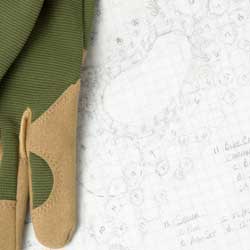 Whether you plan your garden from start to finish or use a professional designer, a few simple steps can help you assess your property’s potential to develop the landscape of your dreams. By getting involved in the landscape design process, you can address practical problems, structure your outdoor living space and develop a plan that will reflect your taste and lifestyle.
Whether you plan your garden from start to finish or use a professional designer, a few simple steps can help you assess your property’s potential to develop the landscape of your dreams. By getting involved in the landscape design process, you can address practical problems, structure your outdoor living space and develop a plan that will reflect your taste and lifestyle.
Surveying Your Site
Every yard, garden and landscape site will have differing light conditions, grade changes, varying soil conditions and existing plants and structures to consider when planning changes and expansions. Using a loose-leaf binder, take notes on each of the following:
Overall:
- What are your favorite spots in your yard and why? What your least favorite and why?
- In landscapes, do you generally prefer open on enclosed spaces?
- What existing plants do you want to preserve, and which do you want to remove?
- What is the architectural style of your home? What is your decorating style?
- Are you planning any additions to your home that may take away yard space?
- Do you want special areas for children, entertaining, pets, recreation, vegetable gardening, water features or composting?
- What is your time frame? Do you want a short-term or long-range plan?
- Which building materials do you like – brick, wood, stone, pavers, etc.?
- Is your outdoor lighting adequate for your use?
- Do you need to screen an area for wind, noise or an unwanted view?
- What is you landscaping budget (both short- and long-term)?
- How will your landscape use change over time, such as when children grow up?
Specific Areas:
- What is the light condition of the area? How does it change seasonally?
- How is the soil – well-drained, poor, heavy clay, poorly drained, etc?
- What are the dimensions of a confined area that could affect plant size?
- What are your favorite plants or types of plants?
- Would you like a garden accent or other feature in this area (trellis, arbor, sculpture, bench, pond, etc)?
- What is the pH and general condition of the soil?
Once you have taken adequate notes, you’ll have a much better understanding about the overall layout of your landscaping site. This can help you plan the best options without making costly or time-consuming mistakes, such as planting the wrong tree that will outgrow a corner in a few years, or choosing building materials that won’t stand up to your climate.
More Tips for Landscape Surveying
You can never have too much information at your fingertips when you are surveying your site for landscaping changes. More techniques that can give you all the information you need include…
- Photographing your property. Snapshots can reveal what the eye may overlook, and can be useful to show others to get their unique perspectives. Take views from your house and various areas of your property. Include photos from different times of day.
- Measure everything and mark it on a map. You can use graph paper to create a simple sketch that will show dimensions so you can properly size your landscaping plans.
- Make a sketch that shows what is existing (plants & structures) and where it is located. This will help you figure out what features you want to preserve, what you may want to expand and what you would rather remove and how the space will change.
Still need help? Bring your information in – we can help you choose the best plants, accents and accessories suitable to your needs, style and budget for the landscape of your dreams!
Attracting Birds to Your Garden
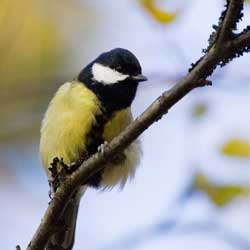 One of the benefits of a garden is the wildlife it attracts, and birds are some of the most popular garden wildlife. Most birds are voracious eaters that are glad to keep the insect population down, and may eat 500-1,000 insects in one afternoon. This makes them ideal for natural (and free!) pest control. Anything you can do to attract birds will make your garden healthier and you’ll be entertained by their feeding antics along the way.
One of the benefits of a garden is the wildlife it attracts, and birds are some of the most popular garden wildlife. Most birds are voracious eaters that are glad to keep the insect population down, and may eat 500-1,000 insects in one afternoon. This makes them ideal for natural (and free!) pest control. Anything you can do to attract birds will make your garden healthier and you’ll be entertained by their feeding antics along the way.
Fortunately, it is easy to attract birds to your garden if you meet their needs for food, shelter, water and overall habitat variety.
Food
While birds will certainly eat insects and may munch on seeds, berries and fruits in the garden, consider placing a variety of bird feeders in your garden to entice even more birds to visit. Platform feeders attract ground birds, hanging feeders are for perching birds and suet holders attract insect-eating birds. Suet is especially important during the winter as this helps birds maintain their body temperature by adding fat to their diet. Hang plastic mesh bags of suet or pinecones dipped in suet (or peanut butter) from the limbs of trees.
For your other feathered guests, white millet and black oil sunflower seeds will attract the most common seed-eating birds and can be sprinkled directly on the ground or added to feeders. Add other species-specific seed like Nyjer (thistle) seed (to attract goldfinches, pine siskins and purple finches) or peanuts (to attract chickadees, jays and tufted titmice) to your buffet. Various gourmet seed mixes are also available like Lyric Supreme, Delight, Chickadee, Woodpecker and Finch Mixes, each of which is blended with specific birds in mind and includes the foods those birds like best.
Shelter and Nesting Sites
Birds feel more secure if they have shelter to protect themselves from the weather and other predators. Plant native trees and shrubs birds will easily recognize as suitable shelter. If your landscape is young and doesn’t include much shelter for birds, don’t worry. Consider building a brush pile or adding a loose woodpile to the yard and birds will happily take advantage of it.
You may also want to add nesting boxes or bird houses and other materials for birds to raise their young. This should be done in late winter or early spring just as birds are beginning to look for nesting sites. Clean houses or boxes after each nesting season.
Water
One of the most important things to include in your bird-friendly garden is water. This is especially true during the winter months. Use a bird bath heater to keep water from freezing. Ideal water sources are 2-3 inches deep and 3 feet off the ground to keep visiting birds safer from prowling predators. Moving water is a magnet for most birds and will attract them from great distances for a drink or bath. A mister, dripper or circulating pump can be added to a bird bath or other water feature during most of the year, but take care to winterize the equipment properly so it does not freeze and break during the coldest months.
Habitat Variety
Because birds live in many different habitats, the variety of plant material you can offer in your backyard will determine how many birds are attracted to your garden. Consider native plants, plants with berries, fruits, sap and nectar for year-round food sources as well as nesting materials. Plan your landscape in tiers and flowing, connected beds so birds can move around easily, and include a variety of both deciduous and evergreen plantings so birds can find the habitat useful year-round.
We carry a complete line of bird feeders, houses, seed mixes and suets as well as garden accents; all the accessories and plants you will need to start attracting birds to your backyard. Stop by today!




